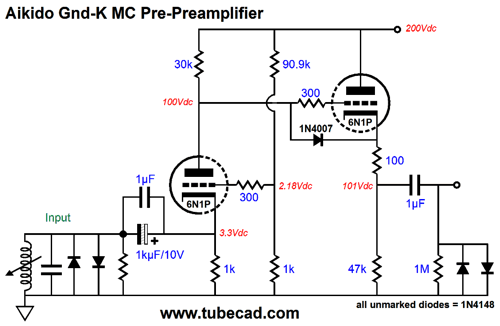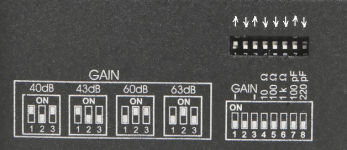I have a Tube SE phono amp I bought that I have been using. It has adjustable gain buttons on the front of it and with the high output MC Denon cart i have I noticed I needed to run it near the bottom of the range to match the volume of my DAC. (PS Audio Directstream). So I got to thinking that instead of running the 12 AX7 that it came with I would try out a 12AU7 and maybe the reduced gain would put me in the middle of my adjustability. So I swap the 12AX7s out with an NOS pair of Mullard 12AU7s. expecting to have to turn the gain up on the amp to get back in the neighborhood of where I was at. WRONG... Its the same damn volume it was with the 12AX7s. How can I go from a gain of 100 to a gain of 20 without any reduction in volume? Is it the secondary half of the hybrid circuit that is compensating for it? And I am now running my output transistors on the phono amp harder? I am confused. it sounds less "rushed" with these tubes. I kind of like it actually. The immediacy of the sound seems lessened. Hard to describe what I mean. But I am curious why its the same volume. with a 80% reduction in gain.
Possibly because the tubes aren't being used for gain at all, and are simply used as a "buffer" i.e. cathode follower setup at the very output of the pre-amp, with all the gain being done with SS electronics. This would also cause the tubes to have very minimal impact on the sonics of the pre-amp.How can I go from a gain of 100 to a gain of 20 without any reduction in volume?
You really need to try to get a schematic, else it's just groping around in the dark.
I agree that the negative feedback will tend to stabilize the gain independent on the active device - that's what fb is used for.
Also, when changing the gain the wrong way you could also upset the RIAA correction; that'll change the sound but not for the good!
If all else fails, use a two-resistor divider at the input to knock down the input signal.
Jan
I agree that the negative feedback will tend to stabilize the gain independent on the active device - that's what fb is used for.
Also, when changing the gain the wrong way you could also upset the RIAA correction; that'll change the sound but not for the good!
If all else fails, use a two-resistor divider at the input to knock down the input signal.
Jan
BEST case those tubes do little, just buffersbas mentioned above.
WORST case they do nothing, just glorified pilot lights, only filamehts connected.
Some even add a couple amber Leds under the socket, because, you know, some people LOVE the orange glow.
Some, like Behringer or Hughes & Kettner, do not even care about orange and use blue LEDs.
YMMV.
In any case, put that 12AX7 back where it belongs,
Hint: rolling different type tubes is a terrible kludge, a 12AU7 is not a "lower gain 12AX7" AT ALL but a very different tube, mainly biasing required which is absolutely different, plate load also, (hint, it passes 8-10X higher current), result is a horribly misbiased mess.
WORST case they do nothing, just glorified pilot lights, only filamehts connected.
Some even add a couple amber Leds under the socket, because, you know, some people LOVE the orange glow.
Some, like Behringer or Hughes & Kettner, do not even care about orange and use blue LEDs.
YMMV.
In any case, put that 12AX7 back where it belongs,
Hint: rolling different type tubes is a terrible kludge, a 12AU7 is not a "lower gain 12AX7" AT ALL but a very different tube, mainly biasing required which is absolutely different, plate load also, (hint, it passes 8-10X higher current), result is a horribly misbiased mess.
The output RCA connectors weem are accessible. Disconnect the center pin on the output RCA connector from the PCB. Place a series of two resistors between the vacated pad and ground, like 10k and 1k, the 1k on the ground side. Connect the resistor midpoint to the RCA output center pin. 20dB attenuation, done.
Jan
Jan
Isn't Modern Technology just adorable?good luck
View attachment 1068712
Literally hundreds of parts in that over-engineered unit, just to hook up a turntable.
And toss in a set of tubes, to make it look more exciting and attractive.
I've seen some reviews of that thing - not all are positive though, yet not surprising.
Back when things were a lot more simpler, that's where my money is spent.
This is exactly the half assed type of comment I have grown to abhor on the internet. You bash "modern technology" without knowing how any of this particular circuit functions. reviews are overwhelmingly positive. Audio Science Review, Analog Planet, vinyl restart, world of turntables, audio advisor, Crutchfield all gave it favorable reviews. I mention this not to defend the amp but solely to point out that you are simply spewing preformed opinions with no basis in reality. "back when things were simpler" you say? This is a fully discrete design which by many standards would be closer to the "good old days" than a modern low part count circuit would. Again I am not advocating one approach over the other just pointing out the contradictory nature of your statement..Isn't Modern Technology just adorable?
Literally hundreds of parts in that over-engineered unit, just to hook up a turntable.
And toss in a set of tubes, to make it look more exciting and attractive.
I've seen some reviews of that thing - not all are positive though, yet not surprising.
Back when things were a lot more simpler, that's where my money is spent.
I knew there was a reason I felt a sense of foreboding as I hit "Post"
I am crawling back into the cave I came from now. For those that made an honest attempt to answer my question I thank you.
And have a nice day to you all.
Have a nice crawl.This is exactly the half assed type of comment I have grown to abhor on the internet. You bash "modern technology" without knowing how any of this particular circuit functions. reviews are overwhelmingly positive. Audio Science Review, Analog Planet, vinyl restart, world of turntables, audio advisor, Crutchfield all gave it favorable reviews. I mention this not to defend the amp but solely to point out that you are simply spewing preformed opinions with no basis in reality.
I knew there was a reason I felt a sense of foreboding as I hit "Post"
I am crawling back into the cave I came from now.
As for me, having a 45+ year professional audio/visual servicing portfolio, and an endless list of satisfied customers from it, your defensiveness and criticism of what I know or don't know means nothing to me.
As for reviews on websites, it's obvious you believe everything that's hyped and posted on the internet.
I, on the other hand, know better.
Please ignore the few hostile people here. I ran into this when I first started posting here and learned there are a handful of "Old guard" types that you have to just learn to ignore.This is exactly the half assed type of comment I have grown to abhor on the internet. You bash "modern technology" without knowing how any of this particular circuit functions. reviews are overwhelmingly positive. Audio Science Review, Analog Planet, vinyl restart, world of turntables, audio advisor, Crutchfield all gave it favorable reviews. I mention this not to defend the amp but solely to point out that you are simply spewing preformed opinions with no basis in reality. "back when things were simpler" you say? This is a fully discrete design which by many standards would be closer to the "good old days" than a modern low part count circuit would. Again I am not advocating one approach over the other just pointing out the contradictory nature of your statement..
I knew there was a reason I felt a sense of foreboding as I hit "Post"
I am crawling back into the cave I came from now. For those that made an honest attempt to answer my question I thank you.
And have a nice day to you all.
I do appreciate your post and hope a few of us were able to help. I'm sure that phono-pre does sound good and a good one can transform a system!
 You forum gorillas can stop your chest banging, it's not needed here.
You forum gorillas can stop your chest banging, it's not needed here.Forum Golden Rule: Attack the idea, don't attack the person.
Be careful or find yourself in MUTE mode.
???""Half assed comment
Obviously you came here for confirmation, expecting to elicit "oooh"s and "aaah"s about your $500 MC preamp ... and you got honest opinion instead.
No likey.
As of
, that means a preamp built around a couple triodes, period, probably with transformer input to match ultra low MC impedance to high tube impedance.when things were a lot more simpler
probably 20 parts in total.
Something like:

or

^^^^ this is what wiseoldtch is talking about.
From what I see in that overstuffed PCB, ICs (Op Amps?) do the main work, say 90% of it, tubes may do something or nothing at all.
Either tubes or Op Amps are redundant, pick one.
Last edited:
- Home
- Amplifiers
- Tubes / Valves
- 'Splain this to me pleeze....
